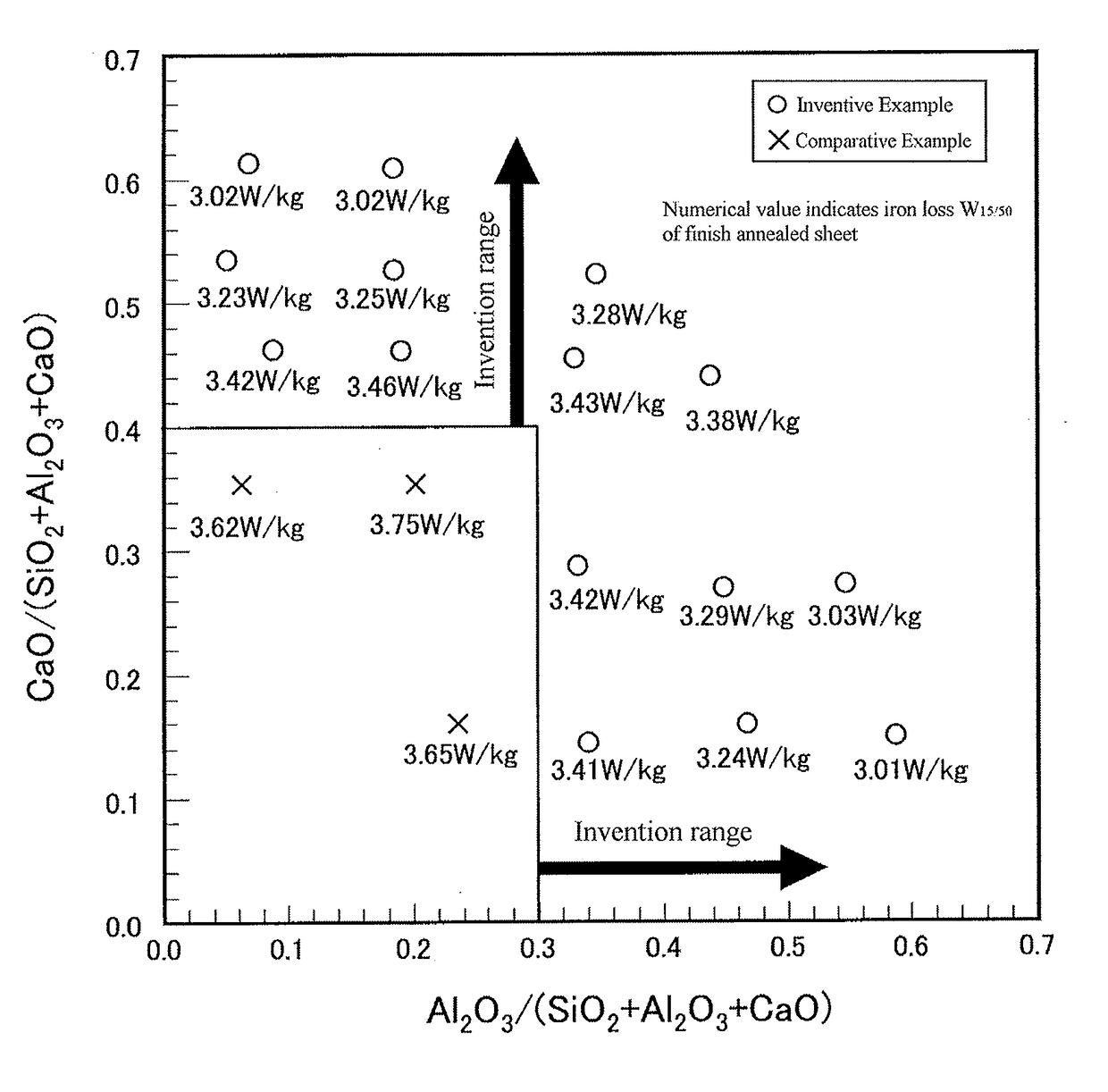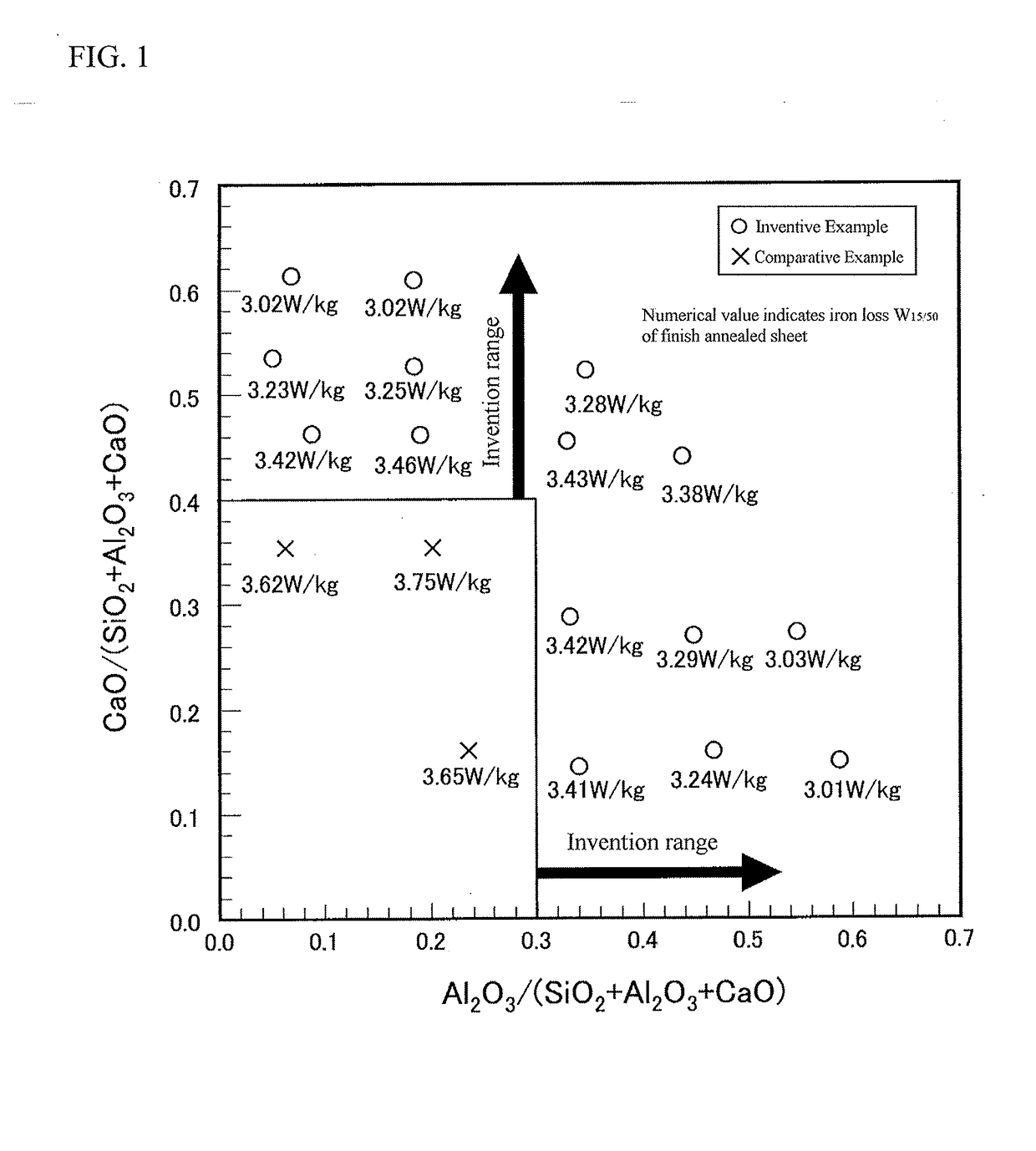Non-oriented electrical steel sheet and method for producing the same
- Summary
- Abstract
- Description
- Claims
- Application Information
AI Technical Summary
Benefits of technology
Problems solved by technology
Method used
Image
Examples
example 1
[0084]Steels A-Q having different chemical compositions shown in Table 1 are melted and shaped into steel slabs by a continuous casting method. In the melting of the steel, Si and Al are mainly used as a deoxidizing agent, and CaSi is added as a Ca source. The addition amount of the deoxidizing agent or CaSi is adjusted in accordance with the N, O or S content in steel.
[0085]Next, the slab is reheated to a temperature of 1050-1130° C. and hot rolled to obtain a hot rolled sheet of 2.3 mm in thickness. In this case, a coiling temperature is 680° C. in all steels.
[0086]Thereafter, the hot rolled sheet is pickled and cold rolled to form a cold rolled sheet having a final sheet thickness of 0.50 mm, which is subjected to a finish annealing at a soaking temperature of 1000° C. and coated with an insulating film to obtain a non-oriented electrical steel sheet (product sheet). In the steel J shown in Table 1, cracking is caused during the hot rolling, and in the steels E and Q, cracking is...
example 2
[0090]Steels R-V having different chemical compositions shown in Table 2 are melted and shaped into slabs by a continuous casting method in the same manner as Example 1. The slab is then reheated to a temperature of 1050-1110° C. and hot rolled to form a hot rolled sheet of 2.3 mm in thickness, which is pickled and cold rolled to obtain a cold rolled sheet having a final thickness of 0.50 mm. Thereafter, the sheet is subjected to a finish annealing at a soaking temperature of 1000° C. and coated with an insulating film to obtain a non-oriented electrical steel sheet (product sheet). In this case, a coiling temperature after the hot rolling is varied in four levels within a range of 600-720° C. as shown in Table 2. Steel V is formed into a hot rolled sheet, which is then subjected to a hot band annealing at a soaking temperature of 1000° C. by continuous annealing and pickled.
[0091]With respect to the thus obtained product sheets, a compositional ratio of CaO and a compositional rati...
example 3
[0093]Steels W-AG having different chemical compositions shown in Table 3 are melted and shaped into slabs by a continuous casting method in the same manner as Example 1. Then, the slab is reheated to a temperature of 1090-1220° C. and hot rolled to form a hot rolled sheet of 2.1 mm in thickness, which is pickled and cold rolled to form a cold rolled sheet having a final thickness of 0.50 mm. Thereafter, the sheet is subjected to a finish annealing at a soaking temperature of 1010° C. and coated with an insulating film to obtain a non-oriented electrical steel sheet (product sheet). In this case, a coiling temperatures after the hot rolling are 670° C. in all steels.
[0094]With respect to the thus obtained product sheets, a compositional ratio of CaO and a compositional ratio of Al2O3 are calculated and the magnetic flux density B50 and iron loss W15 / 50 are measured like Example 1.
TABLE 3MagneticSteelChemical composition (mass %)Inclusion*propertiessym-OtherEqua-Equa-W15 / 50B50bolCSiM...
PUM
| Property | Measurement | Unit |
|---|---|---|
| Temperature | aaaaa | aaaaa |
| Temperature | aaaaa | aaaaa |
| Percent by mass | aaaaa | aaaaa |
Abstract
Description
Claims
Application Information
 Login to View More
Login to View More - R&D
- Intellectual Property
- Life Sciences
- Materials
- Tech Scout
- Unparalleled Data Quality
- Higher Quality Content
- 60% Fewer Hallucinations
Browse by: Latest US Patents, China's latest patents, Technical Efficacy Thesaurus, Application Domain, Technology Topic, Popular Technical Reports.
© 2025 PatSnap. All rights reserved.Legal|Privacy policy|Modern Slavery Act Transparency Statement|Sitemap|About US| Contact US: help@patsnap.com


